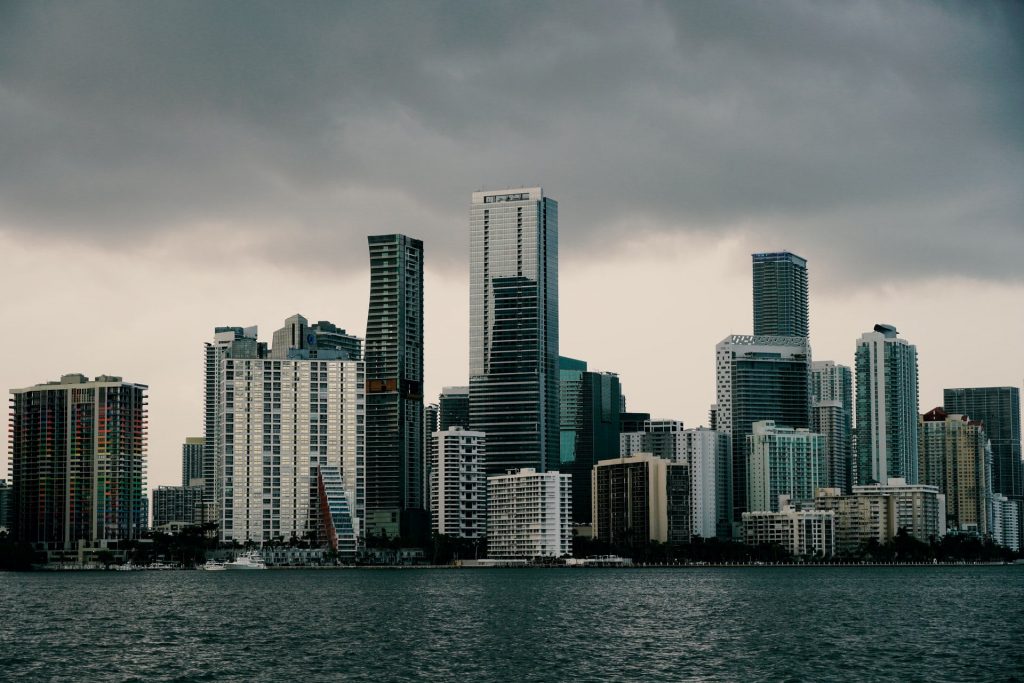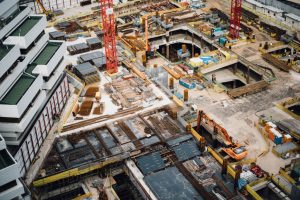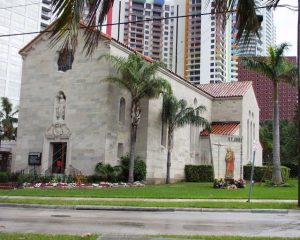 Current Brickell skyline. Tomas Lundahl/Unsplash
Current Brickell skyline. Tomas Lundahl/Unsplash Who is accountable for building on shifting sands?
An SSIT FutureProof Blog Post
When we see a built world, we tend to take its permanence and stability for granted. For those who have chosen coastal homes, that built world goes back at least 50 years, with few residents ever realizing that oceans, lakes, and rivers are living entities constantly in motion.
The average person relies upon experts such as architects and civil engineers, and supposed guardrails such as state building codes and homeowner associations, to assess safety when purchasing property. But the 21st-century assumption that the built world is stable is a risky bet. Especially in “business-friendly” states.
The 21st-century assumption that the built world is stable is a risky bet.
Climate change compounds risk to ocean-adjacent buildings, even in well-regulated states such as New York. Clint Andrews, professor of urban planning at Rutgers University, points out that sea levels are rising faster in the Northeast United States than in Florida. And the effects of salt water and air are equally destructive to all cities near the ocean, regardless of how urban (read: permanent) we consider those places to be.
While the engineering principles and practices related to the foundations of tall buildings are well understood, the implications of each design solution rarely rise to the consciousness of the eventual owners and inhabitants. Anything not directly in the line of sight is taken for granted.
Complacent – until the lawsuits begin?
Complacency is not an option, as vividly illustrated by Alan Weisman’s 2007 The World Without Us. In one of many startling passages, he describes how quickly even a megacity like New York would revert to nature if human maintenance stopped for a couple of months. Weisman’s book was written 14 years ago. It is urgent reading now.
Even so, maintenance of most buildings post-construction focuses on aesthetics, with a naive assumption that the foundation must be reliable and eternal.
Most waterfront residents of the 21st century have never seen a natural coastline, yet the sand is literally shifting beneath their feet and salt is constantly corroding man-made objects. Any boat captain can tell you that maintenance is a perpetual battle against corrosion. How many ever stopped to ask what sort of engineering ensures long-term safety?
Not many, it seems, not even city governments (why bite the hand that feeds you?), until the collapse of the 12-story Champlain Towers South in Surfside, Florida at 1:25 AM on July 22, 2021. No lawsuit — of the many that have been filed — can bring back the dead, heal trauma, or truly recompense financial losses. (In a telling move, the condo board of Champlain Towers has hired Levick, a crisis PR firm that has finessed controversies for the Catholic Church’s sexual abuse scandal, the Ashley Madison hookup website, and the tobacco industry).

The construction of high rises in areas vulnerable to sea level rise relies upon complex engineering that homebuyers rarely stop to consider. CHUTTERSNAP/Unsplash
None of the post-collapse renderings of the Champlain Towers site include the foundation components. It seems a sure sign that most people are utterly unaware of the literal foundations beneath their feet. The public, especially in the anti-intellectual United States, is not interested in being educated, and business interests would be happy to muddy the message.
Killing the goose
The glittering South Florida shoreline evokes the story of the goose that laid the golden egg. It is built on the generous natural buffer that protected the city for decades, which is now so threatened by flooding that a 20-foot seawall was recently proposed to save Miami’s most expensive real estate. “But we can’t have a wall! It would ruin the real estate values!”
As late as the 1970s, the buffer between ocean and land was visible, because the footprint of today’s high-rises on Brickell Avenue once held individual family homes.
Skyscrapers in the sand
Today, the skyline photos Miami shares with the travel industry is a stretch of Brickell Avenue facing Key Biscayne (those photos are not, in fact, of downtown Miami, surprise). Since the 1920s, Brickell Avenue was known as “Millionaire’s Row,” a stretch of stately mansions built so their owners could look down the sloping lawns toward Biscayne Bay from their windows, and traipse down to enjoy the water in a few moments.
Those huge lawns provided safety when hurricanes came close to the Miami shoreline. The water would rise and swamp the wide expanse of St. Augustine grass, sometimes reaching almost to the foundations of the mansions and the Academy of the Assumption, a private girls’ school on the northernmost corner of Brickell. But the hurricane swells never quite reached the mansions or the school, which were constructed of coral rock, marble, terrazzo – heavy materials meant to withstand the sea and the wind.

The St. Jude church, formerly the Assumption Chapel, is one of the few pre-condo buildings left on Brickell Avenue, Miami. Callelinea/English Wikipedia
On a hot, steamy Miami day in the early 1970s, the startling sound of pilings being driven into the nearby bay made it hard to concentrate on schoolwork at the Academy. Pound, pound, pound, thunderous sounds that shook the floor and walls of the girls’ Catholic private school. “Really? They are building a skyscraper there in the sand?” The students of the Academy, mostly daughters of wealthy Latin American exiles who were as jaded and well-traveled as one could be at 13, looked out the school windows at the massive project taking shape just next door and shook their heads.
“Really? They are building a skyscraper there in the sand?”
At the time, the 30-story New World Tower (1965) was the only highrise on Brickell Avenue, and it seemed odd in the context of historic mansions. It was the canary in the coal mine.
The coastal gold rush of the 1980s
The boneshaking sound of pilings being driven into porous Florida limestone tolled the bell for one of Miami’s most important buffers against flooding. The Academy of the Assumption closed in 1976, other landowners on Brickell sold their estates, and the construction of condos rising to 40 stories and more destroyed the delicate tidal zone where fish and crabs and tiny invertebrates and Portuguese man-o-war and pelicans had lived with the tides — and protected the human residents.
Cautionary films were popular in the 1970s — think of “The Towering Inferno” (1974) anticipating impossible high-rise rescues, or “The China Syndrome” (1979, last gasp) warning against falsified nuclear plant inspection reports. But by 1980 it was so-called “morning in America” – the go-go Americans of the Eighties were tired of warnings, preferred nostalgia, and ate dessert first.
The simultaneous emergence of 1980s Miami as an international banking center (and cocaine money haven) accelerated the desire for premier waterfront real estate built by notable architects. But the city cannot replace what it destroyed. Natural barriers to the ocean are priceless and usually irreparable once gone, a lesson Miami and other cities are now forced to face.
Looking back now, the 1980s seem to be the inflection point where our need to pay attention to impending climate change lagged at the time it was most needed, as poignantly reported by The New York Times.
Who is responsible for public safety?
If coastal high-rise residents understood more about the structural components of their buildings, they might ask better questions. They might actually demand that their Homeowners Associations require qualifications for participation, instead of setting the bar so low that anyone can take an online course for $79 that makes them “legal.” Not included in the course outline: Any mention of relevant construction-related experience or knowledge.
The only thing that will put a stop to irresponsible decisions is economic loss.
As new construction proceeds on every available bit of coastal real estate, the friction between the rational (civil engineers and first responders) and the irrational (financial interests, lackadaisical oversight, “but what about that view!” realtors) can only increase to the breaking point. Cue Paul Newman in “The Towering Inferno” as the enraged architect who discovers that corners were cut during construction: “Building code? Jesus. Building code. Come on… I mean that’s a standard cop-out when you’re in trouble… What do they call it when you kill people?”
Technology solutions to increase safety could be implemented if the public demanded it. For example, buildings at risk could be monitored via sensors. Building codes could be strengthened. But commercial interests would fight safety requirements, because building to engineering specifications would reduce the almighty profit.
And there is no technology to prevent sheer human venality, or political pressure.
Florida’s high risk is cultural
Florida is far from the only place whose buildings and infrastructure are at risk. In San Francisco, the notorious 58-story Millennium Tower has sunk 18 inches and tilted 14 inches since it was constructed in 2008. Residents now face a $100 million plan to conduct a “perimeter pile upgrade” – in short, reverse-engineering the type of foundation the City of San Francisco wanted in the first place.
Since California requires buildings to resist earthquakes, the fix may actually be feasible. Californians also expect to be notified as to whether a building is earthquake-safe or not. There is no such transparency in Florida, where cash transactions and money under the table are a way of life in the already-sketchy real estate business. South Florida’s 40-year inspections are only as good as the people who conduct them, and only as useful as the actions taken (or not) by condominium boards and owners.
Days after the Surfside collapse, condo president (and recently elected president of the Key Biscayne Condominium Presidents Council) Fausto Gomez said, “To the best of my knowledge, we have no issues on Key Biscayne.” A property manager quoted in the same article states that “Probably now they might change that requirement to inspect the foundation.” Why does this all sound like magical thinking, come much too late?
The only thing that will put a stop to irresponsible decisions is economic loss. If real-estate buyers started walking away from beachfront high-rises, perhaps public officials would pay attention. In “business-friendly” Florida, long-term thinking has never been top of mind. It took a 16-foot hurricane surge, the loss of 60,000 housing units, and $27.3 billion dollars in damage caused by 1992’s Hurricane Andrew to force building code changes in Florida. Over 60 people died and tens of thousands were displaced.
In Surfside this summer, there was no way to even try to save most of the victims. Not even “The Towering Inferno”s heroic fire captain, embodied by a resigned but resolute Steve McQueen, could have made a difference. Will we allow this to be our future?
Author Information
About Future Proof
Future Proof, a blog of the IEEE Society on Social Implications of Technology, seeks to open a dialog between formal studies on the societal implications of technology and the daily existence of all people.






 JOIN SSIT
JOIN SSIT